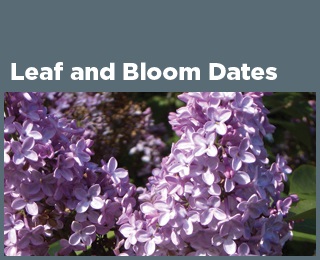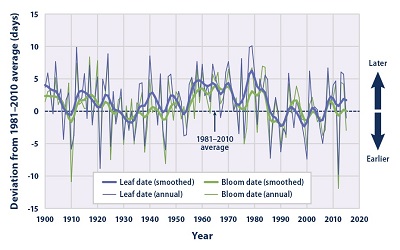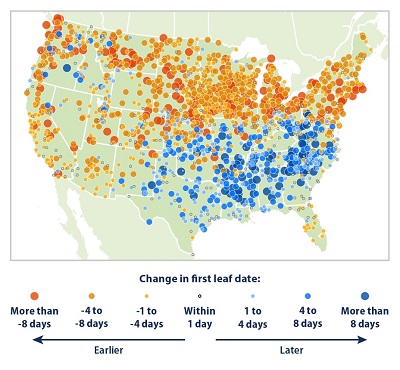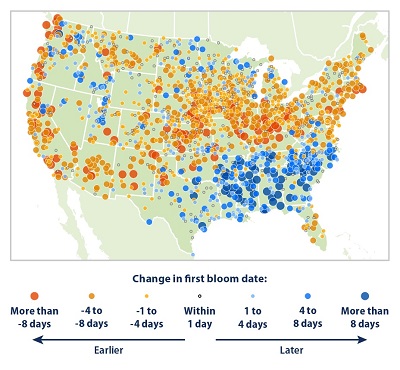|
|
| |
|
|
| |
|
|
|
|
| |
 Climate Change Indicators: Leaf and
Bloom Dates Climate Change Indicators: Leaf and
Bloom Dates
This indicator examines the timing of leaf growth and flower
blooms for two widely distributed plants in the United
States.
Key Points
First leaf and bloom dates in lilacs and honeysuckles in the
contiguous 48 states show a great deal of year-to-year
variability, which makes it difficult to determine whether a
statistically meaningful change has taken place. Earlier
dates appear more prevalent in the last few decades, however
(see Figure 1).
Leaf and bloom events are generally happening earlier
throughout the North and West but later in much of the South
(see Figures 2 and 3). This observation is generally
consistent with regional differences in temperature change
(see the U.S. and Global Temperature indicator).
Other studies have looked at trends in leaf and bloom dates
across all of North America and the entire Northern
Hemisphere. These studies have also found a trend toward
earlier spring events—some more pronounced than the trends
seen in just the contiguous 48 states. |
|
Background
The timing of natural events, such as flower blooms and
animal migration, can be influenced by changes in climate.
Phenology is the study of such important seasonal events.
Phenological events are influenced by a combination of
environmental factors, including temperature, light,
rainfall, and humidity. Different plant and animal species
respond to different cues.
Scientists have high confidence that the earlier arrival of
spring events is linked to recent warming trends in global
climate. Disruptions in the timing of these events can have
a variety of impacts on ecosystems and human society. For
example, an earlier spring might lead to longer growing
seasons (see the Length of Growing Season indicator), more
abundant invasive species and pests, and earlier and longer
allergy seasons. Unusually warm weather in late winter can
create a “false spring” that triggers the new growth of
plants to begin too early, leaving them vulnerable to any
subsequent frosts.
Because of their close connection with climate, the timing
of phenological events can be used as an indicator of the
sensitivity of ecological processes to climate change. Two
particularly useful indicators of the timing of spring
events are the first leaf dates and the first bloom dates of
lilacs and honeysuckles, which have an easily monitored
flowering season, a relatively high survival rate, and a
large geographic distribution. The first leaf date in these
plants relates to the timing of events that occur in early
spring, while the first bloom date is consistent with the
timing of later spring events, such as the start of growth
in forest vegetation. |
|
About the Indicator
This indicator shows trends in the timing of first leaf
dates and first bloom dates in lilacs and honeysuckles
across the contiguous 48 states. Because many of the
phenological observation records in the United States are
less than 40 years long, and because these records may have
gaps in time or space, computer models have been used to
provide a more complete understanding of long-term trends
nationwide.
The models for this indicator were developed using data from
the USA National Phenology Network, which collects ground
observations from a network of federal agencies, field
stations, educational institutions, and citizens who have
been trained to log observations of leaf and bloom dates.
For consistency, observations were limited to a few specific
types of lilacs and honeysuckles. Next, models were created
to relate actual leaf and bloom observations with records
from nearby weather stations. Once scientists were able to
determine the relationship between climate factors
(particularly temperatures) and leaf and bloom dates, they
used this knowledge to estimate leaf and bloom dates for
earlier years based on historical weather records. They also
used the models to estimate how leaf and bloom dates would
have changed in a few areas (mostly in the far South) where
lilacs and honeysuckles are not widespread.
This indicator uses data from nearly 3,000 weather stations
throughout the contiguous 48 states. The exact number of
stations varies from year to year. For each year, the timing
of first leaf and first bloom at each station was compared
with the 1981 to 2010 average to determine the number of
days’ “deviation from normal.” This indicator presents the
average deviation across all stations, along with maps that
compare the most recent 10-year period (2006–2015) with a
mid-20th-century baseline (1951–1960) at individual
stations. These time periods were chosen to match published
studies.
Indicator Notes
Plant phenological events are studied using several data
collection methods, including satellite images, models, and
direct observations. Locational differences, the use of
varying data collection methods, and different phenological
indicators (such as leaf or bloom dates for different types
of plants) can lead to a range of estimates of the arrival
of spring.
Climate is not the only factor that can affect phenology.
Observed variations can also reflect plant genetics, changes
in the surrounding ecosystem, and other factors. This
indicator minimizes the influence of genetic variations by
relying on cloned plants (that is, plants with no genetic
differences).
Data Sources
Leaf and bloom observations were compiled by the USA
National Phenology Network and are available at:
www.usanpn.org. This indicator is also based on temperature
data from the National Oceanic and Atmospheric
Administration’s National Centers for Environmental
Information, which maintains a large collection of climate
data online at:
www.ncei.noaa.gov. Data for this indicator were analyzed
using methods described by Schwartz et al. (2013).
Technical Documentation
Download related technical information PDF |
|
 Figure
1. First Leaf and Bloom Dates in the Contiguous 48
States, 1900–2015 Figure
1. First Leaf and Bloom Dates in the Contiguous 48
States, 1900–2015
This figure shows modeled trends in lilac and honeysuckle
first leaf dates and first bloom dates across the contiguous
48 states, using the 1981 to 2010 average as a baseline.
Positive values indicate that leaf growth and blooming began
later in the year, and negative values indicate that leafing
and blooming occurred earlier. The thicker lines were
smoothed using a nine-year weighted average. Choosing a
different long-term average for comparison would not change
the shape of the data over time.
Data source: Schwartz, 20165 |
 Figure
2. Change in First Leaf Date Between 1951–1960 and
2006–2015 Figure
2. Change in First Leaf Date Between 1951–1960 and
2006–2015
This figure shows modeled trends in lilac and honeysuckle
first leaf dates at weather stations across the contiguous
48 states. This map compares the average first leaf date
during two 10-year periods.
Data source: Schwartz, 20166 |
 Figure
3. Change in First Bloom Date Between 1951–1960 and
2006–2015 Figure
3. Change in First Bloom Date Between 1951–1960 and
2006–2015
This figure shows modeled trends in lilac and honeysuckle
first bloom dates at weather stations across the contiguous
48 states. This map compares the average first bloom date
during two 10-year periods.
Data source: Schwartz, 20167 |
|
|
|
EPA Page |
|
This is the
EPA page for this topic. To see if the Trump
administration has changed the EPA page, simply click the
link and compare the information with this page. If you
notice changes were made to the EPA page, please post a
comment. Thanks. |
|
|
|
|
|
|
|
|
|
|
|
|
Additional Climate Change Information |
Climate Change and Carbon Dioxide
(Beginner - Listening,
reading)
A video lesson to
help with your understanding of climate change
and carbon dioxide.
The English is
spoken at 75% of normal speed.
Great English listening and reading practice. |
Carbon Dioxide and Climate Change
(Beginner - Listening,
reading)
A video lesson to
help with your understanding of carbon dioxide
and climate change.
The English is
spoken at 75% of normal speed.
Great English listening and reading practice. |
Environmental Group Warns Earth's Health at Risk
(Beginner - Listening,
reading)
A video lesson to
help with your understanding of climate change.
The English is
spoken at 75% of normal speed.
Great English listening and reading practice.
A report by the World Wildlife Fund looked at thousands of animal populations
and found they have dropped significantly in 40 years. |
Sea Levels Rising at Fastest Rate in 3,000 years
(Beginner - Listening,
reading)
A video lesson to
help with your understanding of climate change.
The English is
spoken at 75% of normal speed.
Great English listening and reading practice.
A group of scientists say sea levels are rising at record rates. Another group
found that January temperatures in the Arctic reached a record high. |
Capturing CO2 Gas Is Not Easy
(Beginner - Listening,
reading)
A video lesson to
help with your understanding of climate change.
The English is
spoken at 75% of normal speed.
Great English listening and reading practice.
Most scientists agree that carbon-dioxide gas is partly to blame for climate
change: rising global temperatures. But capturing the CO2 gas released by power
stations is costly and difficult. |
Growth, Climate Change Threaten African Plants and
Animals
(Beginner - Listening,
reading)
A video lesson to
help with your understanding of climate change.
The English is
spoken at 75% of normal speed.
Great English listening and reading practice.
Researchers believe Africa may lose as much as 30 percent of its animal and
plant species by the end of this century. |
|
|
|
|
Search Fun Easy English |
|
|
|
|
|
|
|
|
|
|
|
|
|
|
|
About
Contact
Copyright
Resources
Site Map |